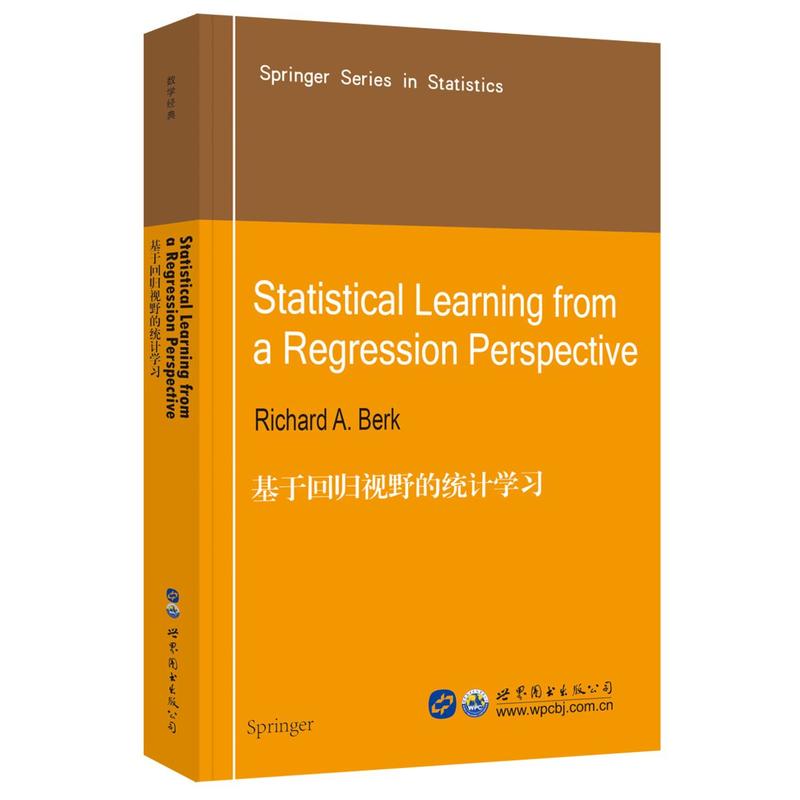
包邮基于回归视野的统计学习
1星价
¥24.1
(3.5折)
2星价¥24.1
定价¥68.0

温馨提示:5折以下图书主要为出版社尾货,大部分为全新(有塑封/无塑封),个别图书品相8-9成新、切口有划线标记、光盘等附件不全详细品相说明>>
买过本商品的人还买了
暂无评论
图文详情
- ISBN:9787519244637
- 装帧:一般胶版纸
- 册数:暂无
- 重量:暂无
- 开本:23cm
- 页数:358页
- 出版时间:2018-05-01
- 条形码:9787519244637 ; 978-7-5192-4463-7
本书特色
《基于回归视野的统计学习》作者是宾夕法尼亚大学数理统计系教授,研究领域广泛,在社会科学和自然科学均有很深的造诣。本书主要阐述统计学习的应用知识,各章还有实际应用实例,可作为统计、社会科学和生命科学等相关领域的研究生和科研人员的参考书。
内容简介
《基于回归视野的统计学习》作者是宾夕法尼亚大学数理统计系教授,研究领域广泛,在社会科学和自然科学均有很深的造诣。本书主要阐述统计学习的应用知识,各章还有实际应用实例,可作为统计、社会科学和生命科学等相关领域的研究生和科研人员的参考书。
目录
Preface
1 Statistical Learning as a Regression Problem
1.1 Getting Started
1.2 Setting the Regression Context
1.3 The Transition to Statistical Learning
1.3.1 Some Goals of Statistical Learning
1.3.2 Statistical Inference
1.3.3 Some Initial Cautions
1.3.4 A Cartoon Illustration
1.3.5 A Taste of Things to Come
1.4 Some Initial Concepts and Definitions
1.4.1 Overall Goals
1.4.2 Loss Functions and Related Concepts
1.4.3 Linear Estimators
1.4.4 Degrees of Freedom
1.4.5 Model Evaluation
1.4.6 Model Selection
1.4.7 Basis Functions
1.5 Some Common Themes
1.6 Summary and Conclusions
2 Regression Splines and Regression Smoothers
2.1 Introduction
2.2 Regression Splines
2.2.1 Applying a Piecewise Linear Basis
2.2.2 Polynomial Regression Splines
2.2.3 Natural Cubic Splines
2.2.4 B-Splines
2.3 Penalized Smoothing
2.3.1 Shrinkage
2.3.2 Shrinkage and Statistical Inference
2.3.3 Shrinkage: So What?
2.4 Smoothing Splines
2.4.1 An Illustration
2.5 Locally Weighted Regression as a Smoother
2.5.1 Nearest Neighbor Methods
2.5.2 Locally Weighted Regression
2.6 Smoothers for Multiple Predictors
2.6.1 Smoothing in Two Dimensions
2.6.2 The Generalized Additive Model
2.7 Smoothers with Categorical Variables
2.7.1 An Illustration
2.8 Locally Adaptive Smoothers
2.9 The Role of Statistical Inference
2.9.1 Some Apparent Prerequisites
2.9.2 Confidence Intervals
2.9.3 Statistical Tests
2.9.4 Can Asymptotics Help?
2.10 Software Issues
2.11 Summary and Conclusions
3 Classification and Regression Trees (CART)
3.1 Introduction
3.2 An Overview of Recursive Partitioning with CART
3.2.1 Tree Diagrams
3.2.2 Classification and Forecasting with CART
3.2.3 Confusion Tables
3.2.4 CART as an Adaptive Nearest Neighbor Method
3.2.5 What CART Needs to Do
3.3 Splitting a Node
3.4 More on Classification
3.4.1 Fitted Values and Related Terms
3.4.2 An Example
3.5 Classification Errors and Costs
3.5.1 Default Costs in CART
3.5.2 Prior Probabilities and Costs
3.6 Pruning
3.6.1 Impurity Versus Rа(T)
3.7 Missing Data
3.7.1 Missing Data with CART
3.8 Statistical Inference with CART
3.9 Classification Versus Forecasting
3.10 Varying the Prior, Costs, and the Complexity Penalty
3.11 An Example with Three Response Categories
3.12 CART with Highly Skewed Response Distributions
3.13 Some Cautions in Interpreting CART Results
3.13.1 Model Bias
3.13.2 Model Variance
3.14 Regression Trees
3.14.1 An Illustration
3.14.2 Some Extensions
3.14.3 Multivariate Adaptive Regression Splines (MARS)
3.15 Software Issues
3.16 Summary and Conclusions
4 Bagging
4.1 Introduction
4.2 Overfitting and Cross-Validation
4.3 Bagging as an Algorithm
4.3.1 Margins
4.3.2 Out-Of-Bag Observations
4.4 Some Thinking on Why Bagging Works
4.4.1 More on Instability in CART
4.4.2 How Bagging Can Help
4.4.3 A Somewhat More Formal Explanation
4.5 Some Limitations of Bagging
4.5.1 Sometimes Bagging Does Not Help
4.5.2 Sometimes Bagging Can Make the Bias Worse
4.5.3 Sometimes Bagging Can Make the Variance Worse
4.5.4 Losing the Trees for the Forest
4.5.5 Bagging Is Only an Algorithm
4.6 An Example
4.7 Bagging a Quantitative Response Variable
4.8 Software Considerations
4.9 Summary and Conclusions
5 Random Forests
5.1 Introduction and Overview
5.1.1 Unpacking How Random Forests Works
5.2 An Initial Illustration
5.3 A Few Formalities
5.3.1 What Is a Random Forest?
5.3.2 Margins and Generalization Error for Classifiers in General
5.3.3 Generalization Error for Random Forests
5.3.4 The Strength of a Random Forest
5.3.5 Dependence
5.3.6 Implications
5.4 Random Forests and Adaptive Nearest Neighbor Methods
5.5 Taking Costs into Account in Random Forests
5.5.1 A Brief Illustration
5.6 Determining the Importance of the Predictors
5.6.1 Contributions to the Fit
5.6.2 Contributions to Forecasting Skill
5.7 Response Functions
5.7.1 An Example
5.8 The Proximity Matrix
5.8.1 Clustering by Proximity Values
5.8.2 Using Proximity Values to Impute Missing Data
5.8.3 Using Proximities to Detect Outliers
5.9 Quantitative Response Variables
5.10 Tuning Parameters
5.11 An Illustration Using a Binary Response Variable
5.12 An Illustration Using a Quantitative Response Variable
5.13 Software Considerations
5.14 Summary and Conclusions
5.14.1 Problem Set 1
5.14.2 Problem Set 2
5.14.3 Problem Set 3
6 Boosting
6.1 Introduction
6.2 Adaboost
6.2.1 A Toy Numerical Example of Adaboost
6.2.2 A Statistical Perspective on Adaboost
6.3 Why Does Adaboost Work So Well?
6.3.1 Least Angle Regression (LARS)
6.4 Stochastic Gradient Boosting
6.4.1 Tuning Parameters
6.4.2 Output
6.5 Some Problems and Some Possible Solutions
6.5.1 Some Potential Problems
6.5.2 Some Potential Solutions
6.6 Some Examples
6.6.1 A Garden Variety Data Analysis
6.6.2 Inmate Misconduct Again
6.6.3 Homicides and the Impact of Executions
6.6.4 Imputing the Number of Homeless
6.6.5 Estimating Conditional Probabilities
6.7 Software Considerations
6.8 Summary and Conclusions
7 Support Vector Machines
7.1 A Simple Didactic Illustration
7.2 Support Vector Machines in Pictures
7.2.1 Support Vector Classifiers
7.2.2 Support Vector Machines
7.3 Support Vector Machines in Statistical Notation
7.3.1 Support Vector Classifiers
7.3.2 Support Vector Machines
7.3.3 SVM for Regression
7.4 A Classification Example
7.4.1 SVM Analysis with a Linear Kernel
7.4.2 SVM Analysis with a Radial Kernel
7.4.3 Varying Tuning Parameters
7.4.4 Taking the Costs of Classification Errors into Account
7.4.5 Comparisons to Logistic Regression
7.5 Software Considerations
7.6 Summary and Conclusions
8 Broader Implications and a Bit of Craft Lore
8.1 Some Fundamental Limitations of Statistical Learning
8.2 Some Assets of Statistical Learning
8.2.1 The Attitude Adjustment
8.2.2 Selectively Better Performance
8.2.3 Improving Other Procedures
8.3 Some Practical Suggestions
8.3.1 Matching Tools to Jobs
8.3.2 Getting to Know Your Software
8.3.3 Not Forgetting the Basics
8.3.4 Getting Good Data
8.3.5 Being Sensitive to Overtuning
8.3.6 Matching Your Goals to What You Can Credibly Do
8.4 Some Concluding Observations
References
Index
展开全部
作者简介
《基于回归视野的统计学习》作者是宾夕法尼亚大学数理统计系教授,研究领域广泛,在社会科学和自然科学均有很深的造诣。
本类五星书
本类畅销
-

改变世界的发现
¥17.8¥48.0 -

勒维特之星-大发现系列丛书
¥4.8¥16.0 -

艾萨克·牛顿、理性时代与现代科学的肇始(八品-九品)
¥28.8¥96.0 -

世纪幽灵-走近量子纠缠
¥9.4¥28.0 -

大学物理简明教程·第4版
¥45.4¥56.0 -

13次时空穿梭之旅
¥20.1¥59.0 -

130种美鸟彩图馆
¥19.9¥39.8 -

考研数学公式手册
¥2.2¥3.2 -

物理学之美-插图珍藏版
¥29.0¥69.0 -

数学的魅力;初等数学概念演绎
¥9.4¥22.0 -

趣味物理学问答
¥15.7¥46.0 -

昆虫采集制作及主要目科简易识别手册
¥16.0¥50.0 -

古文诗词中的地球与环境事件
¥9.4¥28.0 -

高等数学.第七版.下册
¥13.8¥42.8 -

人机对齐
¥75.5¥98.0 -

濒危植物图鉴
¥131.3¥268.0 -

离散数学(第六版)
¥43.4¥49.9 -

中国古代天文历法与二十四节气
¥20.2¥40.0 -

模形式初步
¥133.5¥178.0 -

昆虫的生存之道
¥13.2¥38.0












